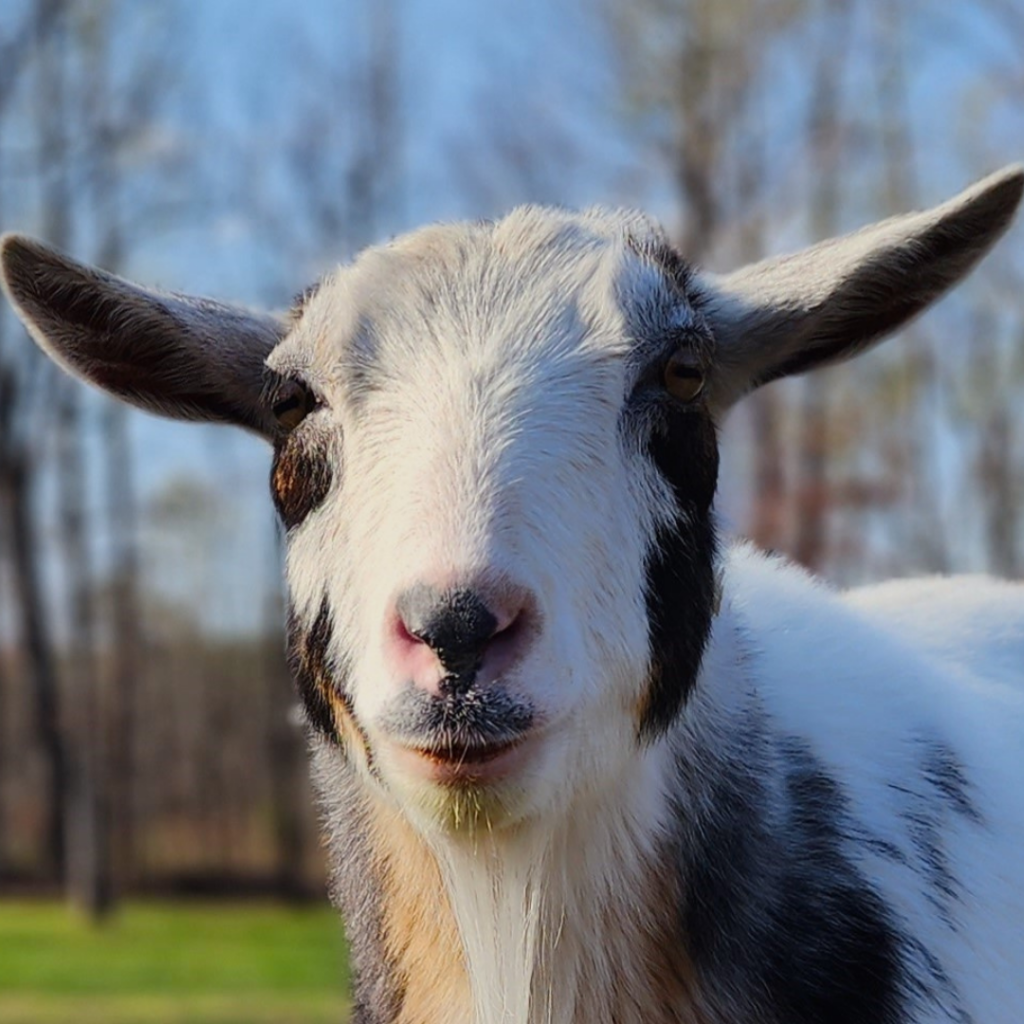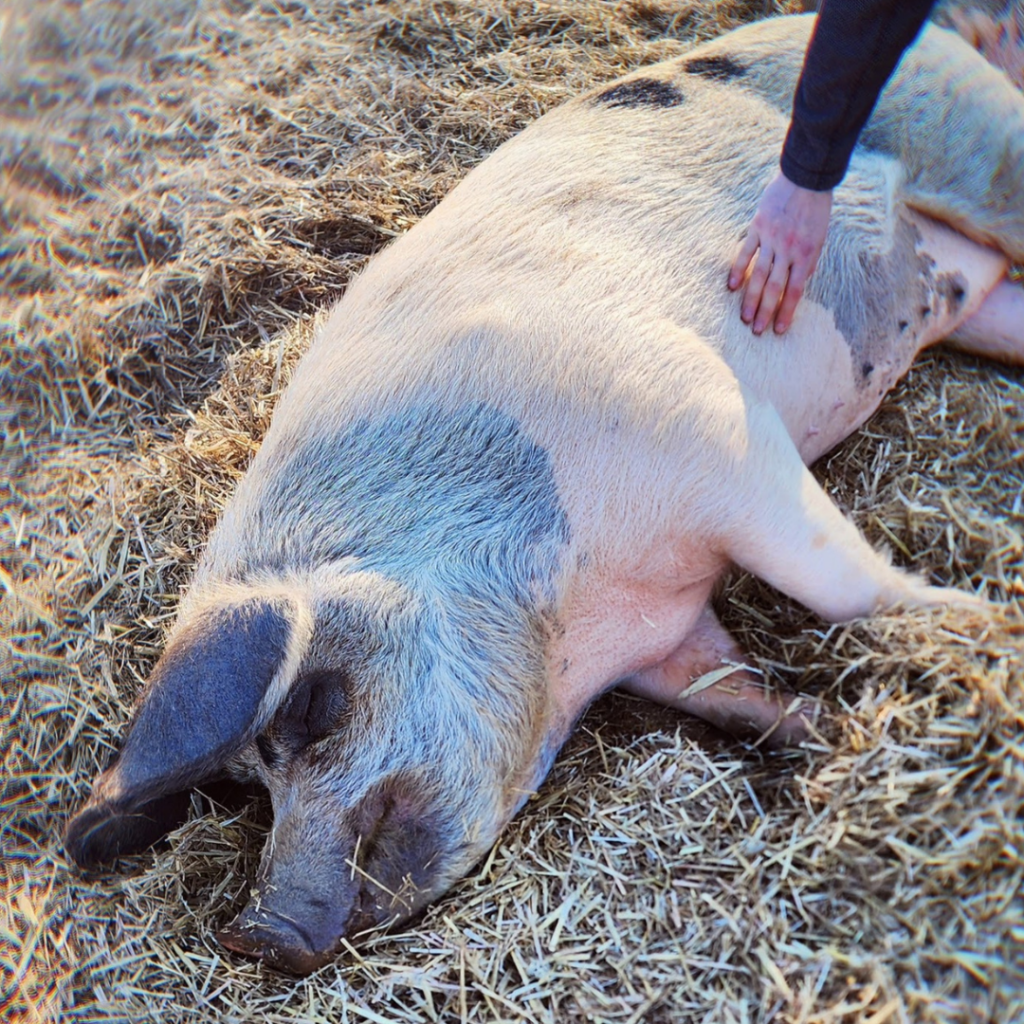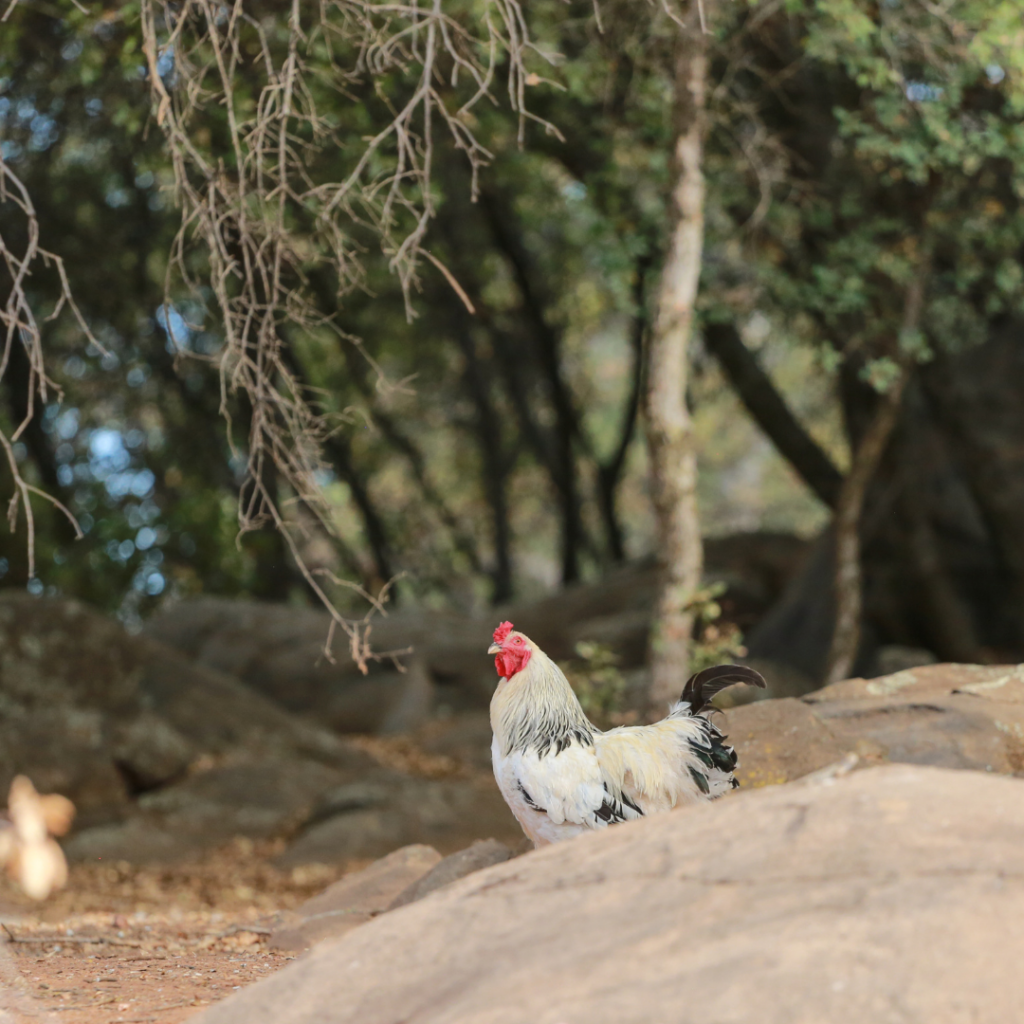
Resource Acknowledgement
The following resource was originally developed for The Open Sanctuary Project as part of Dr. Emily Tronetti’s dissertation project in pursuance of her Doctor of Education (EdD) through Antioch University and the Institute for Humane Education. Emily specializes in adult humane education and applied animal behavior, and is passionate about helping advocates and organizations cultivate compassionate coexistence through teaching about and supporting the agency and wellbeing of other animals. We are so grateful for her collaborative efforts and contributions to The Open Sanctuary Project.
This Resource is Part Three of a Fully-Downloadable Guide!
This resource is the third part of a fully-downloadable guide that was originally developed as a comprehensive resource to help sanctuary educators foster and teach about farmed animalA species or specific breed of animal that is raised by humans for the use of their bodies or what comes from their bodies. agency and consent in the context of sanctuary education and outreachAn activity or campaign to share information with the public or a specific group. Typically used in reference to an organization’s efforts to share their mission.. In our efforts to make larger resources like the fully-downloadable guide as accessible as possible in various formats, we broke it down into six individual parts/resources. If you’re interested in reading the fourth part of the original resource, “A Guide to Fostering Farmed Animal Agency in Sanctuary Education: Part Four”, please click here. If you’d like to access the fully-downloadable guide, please click here.
Non-Compassionate Sources
We at The Open Sanctuary Project disavow animal experimentation and any “use” of animals for human purposes. Because compassionate studies on valuing the personality, intelligence, and unique attributes of many nonhuman animals are rare, in this resource, we draw from existing sources that may be non-compassionate. Still, we may use the information we find to improve the lives of residents. We strive towards a future when compassionate, non-exploitative, and non-invasive research is the norm. In the meantime, we will work with what we have to help sanctuaries help animals as effectively as possible. You can read a little bit more about our non-compassionate source policy here.
Reflection Questions
Throughout this resource, you will notice questions in boxes like this. To get the most out of this guide, we encourage you to pause and reflect on each question and discuss them with your colleagues. To help with this, please click here for a list of the reflection questions and space for you to share your thoughts.
Why Are Agency and Consent Important in Sanctuary Education?
In sanctuary education, we are in perpetual pursuit of striking a careful balance between providing informative, impactful, and enjoyable experiences for visitors while also respecting the agency and space of sanctuary residents. How organizations may go about this varies from sanctuary to sanctuary and depends on many factors, such as the environment, the residents, and the humans involved. Despite wanting to advocate on behalf of residents as thoughtfully and compassionately as possible, it can sometimes be challenging to prioritize their agency. Strangely, doing so can sometimes feel counterproductive to our educational objectives.
For example, as mentioned earlier, sanctuaries that invite the public into their spaces may face external and/or internal pressure to provide direct contact with the residents. This typically stems from the idea that direct contact with sanctuary residents will lead to the most significant changes in people’s beliefs and behaviors towards farmed animalsA species or specific breed of animal that is raised by humans for the use of their bodies or what comes from their bodies., including their intentions to reduce their consumption of animal productsAnything that originates from an animal’s body, including things like their eggs, feathers, flesh, honey, milk, and wool.. So, educators may bring the visitors into the residents’ paddocks or barns and encourage people to touch them. Some individual animals may welcome this engagement, but others may not.
While many sanctuaries strive to distinguish themselves from petting zoos, we should consider to what degree our sanctuary visitor experiences actually differ from those in petting zooAn organization where animals, either rescued, bought, borrowed, or bred, are kept, typically for the benefit of human visitor interest. settings. What messages about human-nonhuman relations are the visitors receiving either implicitly or explicitly? What are they learning if they’re not instructed to consider consent when interacting with a farmed animal? Do we, as sanctuary educators, know how to interpret the body language, behavior, and perspective of every resident to determine if they consent to a particular interaction or experience with a visitor?
Nurture Agency-Centered Interactions
In each interaction we facilitate with residents, we should ask ourselves: “In this moment, is this interaction supporting or suppressing resident agency?” If we determine their agency is being suppressed, the next question we should ask ourselves is, “In what ways can I support this resident’s agency instead?”.
While agency and consent are especially important when people directly interact with the residents, we should remain aware of these concepts in all forms of sanctuary education. For example, videos posted on social media of sanctuary residents interacting with staff are sending implicit messages to followers about how farmed animals should be treated. If the videos show staff members unaware of or ignoring agency and consent, what messages might this send, and what are the implications of those messages? In all forms of sanctuary education, it’s critically important to be aware of any hidden, unintended messages we may be sending or beliefs we may be reinforcing, particularly with regard to “forms of animal viewing that could reinforce implicit assumptions about a human entitlement to confine and display animals” (Donaldson & Kymlicka, 2015, p. 55).
If our goals as sanctuary educators include challenging oppressive power dynamics in how humans treat other animals and, instead, inspiring folks to think more critically about these relationships, it’s important to ensure our educational approaches align with these goals. One powerful strategy is to bring awareness to and acknowledge how our residents’ agency may be suppressed or even denied within the sanctuary and strive to change that. This means letting residents take the lead in our interactions with them as much as possible. They typically know better than we do what “activities or interactions are in their own interest” (Healey & Pepper, 2021, p. 1227). In sanctuary education, if visitors, supporters, and online viewers witness residents genuinely having a say in what happens to them, perhaps we can begin to truly disrupt the way in which “humans have granted themselves dominion over the planet and all other species, creating a hierarchy in which [some] humans are the definition and measure of everything worthy” (Saari, 2018, p. 2).

“Figuring out what animals want is an act of interpretation, based on scientific knowledge and expertise; it can—and should—also be an act of advocacy. Attending to well-being means attending to real freedoms, including the psychological benefits for animals of choice, control, and agency.”
Bekoff & Pierce, 2017, p. 29
The most crucial reason why fostering farmed animal agency is important in sanctuary education is because it’s what’s best for resident well-being. It’s worth repeating that agency is vital to psychological and physical health, and suppressed agency can lead to negative consequences and feelings such as fear and anxiety (Bekoff & Pierce, 2017; McMillan, 2020; Mellor et al., 2020). Agency-centered care and education can help support our residents in their ability to cope with and flourish in their environments (Špinka & Wemelsfelder, 2011). This often looks like creating space, literally and figuratively, for each resident to be who they are. As staff and volunteers learn more about each individual, this knowledge can then be used to provide more personalized general care, as well as accommodations during education and outreach events. Understanding the residents in this way, in combination with learning and teaching about how to attend to and respect their agency and consent, promotes safer, more comfortable interactions for all involved.
For example, we may discover a goat is stressed by the presence of unfamiliar humans while the rest of her curious herd members enjoy it. We might try giving that goat plenty of space to retreat and instruct visitors not to approach her. Or perhaps she’d prefer to be moved to a more secluded but enriching area when folks are visiting with the rest of the herd. There are various accommodations we can make as sanctuary educators that could reduce her stress and possible stress-induced behaviors, like head-butting. She would feel safer, and the humans she might have been tempted to head-butt would be safer, too!
Ultimately, agency and consent in sanctuary education can deepen the residents’ trust and relationships with humans. It can also promote empathy and reverence for residents, including those who aren’t interested in having relationships with humans. These individuals are just as important and deserving of compassion. By deepening our knowledge of the sanctuary’s residents and incorporating what we learn into what we teach, we foster a perception of farmed animals as thinking, feeling, complex beings who want, need, and deserve to have a say in what happens to them. In recognizing and advocating for their agency and consent, we shift the focus from our own desires and needs to the well-being of the residents. These perspectives encourage us and our learners to question and challenge power dynamics and the dominant belief systems that have been used to justify the exploitationExploitation is characterized by the abuse of a position of physical, psychological, emotional, social, or economic vulnerability to obtain agreement from someone (e.g., humans and nonhuman animals) or something (e.g, land and water) that is unable to reasonably refuse an offer or demand. It is also characterized by excessive self gain at the expense of something or someone else’s labor, well-being, and/or existence. of nonhuman animals for human benefit.
“Decision making at sanctuaries is fraught, mistakes are made, and ethical issues are often unresolved. Yet sanctuaries are spaces where these considerations are made, carefully and repeatedly, with individual animals’ needs, preferences, and social connections in mind. One of the projects of sanctuary work, then, is consistent attention to how these mechanisms of power and control can be mitigated as much as possible.”
Gillespie, 2021, p. 11

Agency-centered education and advocacy in sanctuary settings help ensure that we aren’t reproducing the oppressive practices present in animal agricultureThe human production and use of animals in order to produce animal products, typically for profit. and other forms of exploitation while also bringing to light how unjust and harmful these systems are. Even in sanctuaries, we might make assumptions about how other animals want to live because of traditional ways of viewing and caring for them (Abrell, 2021). However, as sanctuary staff and volunteers discover and practice ways of being in relation with residents that align even more deeply with their own needs and desires, we expose the extent to which farmed animals have their agency denied in other settings and the impacts this has. This also allows us to model alternative, more equitable ways of coexisting with farmed animals and opens up the possibility for “mutual flourishing” (Gillespie, 2021).
Reflection Questions
When you read the term “mutual flourishing,” what comes to mind? What do you think it would look like to mutually flourish with farmed animals? How might this vision guide your work as a sanctuary educator?
As we delve deeper into the topic of agency-centered education, we’ll discover that it promotes and is promoted by various skills, such as mindfulness, empathy, curiosity, and critical reflection, which are all interconnected. When we’re with other animals, mindfulness and the practice of being present are essential. We must allow ourselves the space and time to really notice what they’re communicating and how they’re experiencing the interaction and the surrounding environment. Skills like curiosity and critical reflection also help us to be more observant of other animals, and empathy helps us better understand what they might be feeling and experiencing (Gruen, 2015; Young et al., 2018). With this information, we can make more informed, compassionate choices that center the needs of the other animals we’re interacting with. As sanctuary educators, it’s important that we practice and hone these skills in ourselves and cultivate them in others. Doing so will also make it more possible for folks to extend their compassion and empathy to farmed animals and other species outside of sanctuary settings.
Interested in Learning More?
Interested in learning more about fostering farmed animal agency and consent in sanctuary education? Please click here to read the fourth part of this guide!
We’d Love to Hear from You!
This guide is a living document that we plan to make continual changes to as we get feedback from sanctuary staff and volunteers who have implemented what they’ve learned from this guide into their sanctuary education practices. In our efforts to ensure this guide is as helpful as possible to sanctuary staff, volunteers, visitors, supporters, and, most importantly, the residents, we’d love to hear how this guide has impacted your work. If you have feedback, please contact us here!
Sources
A Guide to Fostering Farmed Animal Agency in Sanctuary Education | The Open Sanctuary Project
Strategic Planning for Educational Programming at Your Animal Sanctuary | The Open Sanctuary Project
The Differences Between an Animal Sanctuary and a Petting Zoo | The Open Sanctuary Project
All About Social Media for Your Animal Sanctuary | The Open Sanctuary Project
Fostering Critical Thinking at Your Animal Sanctuary | The Open Sanctuary Project
Time to Thrive: The Importance of Enrichment | The Open Sanctuary Project
Fostering Empathy Towards Farmed Animals | The Open Sanctuary Project
Observation: An Important Caregiving Tool | The Open Sanctuary Project
Farmed Animal Sanctuaries: The Heart of the Movement? | Sue Donaldson & Will Kymlicka
Interspecies Justice: Agency, Self-Determination, and Assent | Richard Healey & Angie Pepper
Re-examining the Human-Nonhuman Animal Relationship Through Humane Education | Maria Helena Saari
The Mental Health and Well-Being Benefits of Personal Control in Animals | F. D. McMillan
The 2020 Five Domains Model: Including Human–Animal Interactions in Assessments of Animal Welfare | David J. Mellor, Ngaio J. Beausoleil, Katherine E. Littlewood, Andrew N. McLean, Paul D. McGreevy, Bidda Jones, & Cristina Wilkins (Non-Compassionate Source)
Environmental Challenge and Animal Agency | Marek Špinka & Françoise Wemelsfelder (Non-Compassionate Source)
Saving Animals: Multispecies Ecologies of Rescue and Care | Elan Abrell
Entangled Empathy: An Alternative Ethic for Our Relationships with Animals | Lori Gruen
Non-Compassionate Source?
If a source includes the (Non-Compassionate Source) tag, it means that we do not endorse that particular source’s views about animals, even if some of their insights are valuable from a sanctuary perspective. See a more detailed explanation here.






